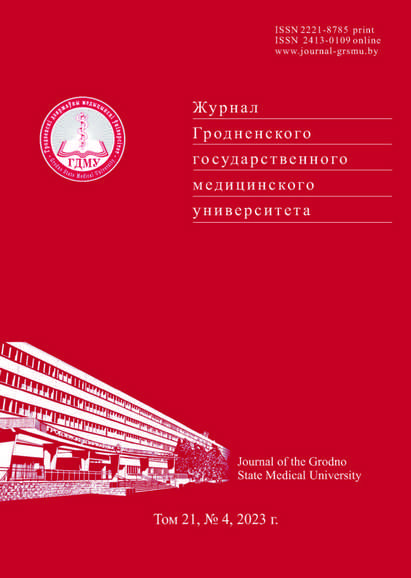БИОМАРКЕРЫ КРОВИ – ПРЕДИКТОРЫ РАЗВИТИЯ ИШЕМИЧЕСКОГО ИНСУЛЬТА: НОВЫЙ ВЗГЛЯД НА ИЗВЕСТНЫЕ МОЛЕКУЛЫ

Аннотация
Ежегодное количество инсультов и смертей от инсульта в мире увеличивается, при этом на долю ишемического инсульта (ИИ) приходится около 80% случаев. Цель настоящего обзора. Анализ результатов исследований, оценивающих значимость измерения разных биомаркеров в прогнозировании риска развития ИИ. На сегодняшний день в исследованиях активно изучается перспективность ряда воспалительных (C реактивный белок, фибриноген, провоспалительные цитокины и др.), гемодинамических, кардиальных, метаболических биомаркеров, которые могут применяться для повышения точности стратификации риска развития ИИ. В настоящее время трудно выделить тот скрининговый биомаркер, который наиболее диагностически значим для оценки риска развития инсульта. Так, по данным ряда исследований и метаанализов, высокочувствительный С-реактивный белок выступает диагностически значимым биомаркером ИИ. Требует дальнейшего изучения роль высокочувствительного тропонина I и натрийуретического пептида в диагностике риска ИИ. Перспективным представляется оценка триглицерид-глюкозного индекса, АроB, ApoA1, асимметричного диметиларгинина, мочевой кислоты – однако еще предстоит выяснить их возможную роль в реклассификации бессимптомных пациентов в дополнение к уже имеющимся шкалам, основанным на традиционных факторах риска.
Литература
GBD 2019 Stroke Collaborators. Global, regional, and national burden of stroke and its risk factors, 1990-2019: a systematic analysis for the Global Burden of Disease Study 2019. Lancet Neurol. 2021;20(10):795-820. https://doi.org/10.1016/S1474-4422(21)00252-0.
Donkor ES. Stroke in the 21st Century: A Snapshot of the Burden, Epidemiology, and Quality of Life. Stroke Res Treat. 2018;3:1-10. https://doi.org/10.1155/2018/3238165.
Bamford J, Sandercock P, Dennis M, Burn J, Warlow C. Classification and natural history of clinically identifiable subtypes of cerebral infarction. Lancet. 1991;337(8756):1521-1526. https://doi.org/10.1016/0140-6736(91)93206-o.
Smychek VB, Vasilchenko NI. Disability caused by stroke in the republic of Belarus. Healthcare. 2018;5:11-17. edn: XTGZBB. (Russian).
Zubareva MYu, Susekov AV. The program of lowering of resudual risk (the Residual Risk Reduction Initiative). Part I. Factors of residual risk. Kardiologiia. 2010;50(8):76-83. edn: MYNPCF. (Russian).
Dhindsa DS, Sandesara PB, Shapiro MD, Wong ND. The Evolving Understanding and Approach to Residual Cardiovascular Risk Management. Front Cardiovasc Med. 2020;7:88. https://doi.org/10.3389/fcvm.2020.00088.
Biomarkers Definitions Working Group. Biomarkers and surrogate endpoints: Preferred definitions and conceptual framework. Clin Pharmacol Ther. 2001;69(3):89-95. https://doi.org/10.1067/mcp.2001.113989.
Whiteley W, Tian Y, Jickling GC. Blood Biomarkers in stroke: research and clinical practice. Int J Stroke. 2012;7(5):435-439. https://doi.org/10.1111/j.1747-4949.2012.00784.x.
Kim SJ, Moon GJ, Bang OY. Biomarkers for stroke. J Stroke. 2013;15(1):27-37. https://doi.org/10.5853/jos.2013.15.1.27.
Andone S, Bajko Z, Motataianu A, Mosora O, Balasa R. The Role of Biomarkers in Atherothrombotic Stroke-A Systematic Review. Int J Mol Sci. 2021;22(16):9032. https://doi.org/10.3390/ijms22169032.
Zanetti D, Gustafsson S, Assimes TL, Ingelsson E. Comprehensive Investigation of Circulating Biomarkers and Their Causal Role in Atherosclerosis-Related Risk Factors and Clinical Events. Circ Genom Precis Med. 2020;13(6):e002996. https://doi.org/10.1161/CIRCGEN.120.002996.
Rost NS, Wolf PA, Kase CS, Kelly-Hayes M, Silbershatz H, Massaro JM, D’Agostino RB, Franzblau C, Wilson PW. Plasma concentration of C-reactive protein and risk of ischemic stroke and transient ischemic attack: the Framingham study. Stroke. 2001;32(11):2575-2579. https://doi.org/10.1161/hs1101.098151.
Kaptoge S, Angelantonio ED, Lowe G, Pepys MB, Thompson SG, Collins R, Danesh J. C-reactive protein concentration and risk of coronary heart disease, stroke, and mortality: an individual participant meta-analysis. Lancet. 2010;375(9709):132-140. https://doi.org/10.1016/S0140-6736(09)61717-7.
Zhou Y, Han W, Gong D, Man C, Fan Y. Hs-CRP in stroke: A meta-analysis. Clinica Chimica Acta. 2016;453:21-27. https://doi.org/10.1016/j.cca.2015.11.027.
Xu T, Ke K. C-reactive protein and ischemic stroke risk in general population: A dose-response meta-analysis of prospective studies. Int J Cardiol. 2015;190:264-267. https://doi.org/10.1016/j.ijcard.2015.04.176.
Yang X, Zhang D, Zhao Y, Liu D, Li Q, Guo C, Tian G, Han M, Qie R, Huang S, Zhou Q, Zhao Y, FengY, Wu X, Zhang Y, Li Y, Wu Y, Cheng C, Hu D, Sun L. Association between serum level of C-reactive protein and risk of cardiovascular events based on cohort studies. J Hum Hypertens. 2021;35(12):1149-1158. https://doi.org/10.1038/s41371-021-00546-z.
Danesh J, Lewington S, Thompson SG, Lowe GDO, Collins R, Kostis JB, Wilson AC, Folsom AR, Wu K, Benderly M, Goldbourt U, Willeit J, Kiechl S, Yarnell JWG, Sweetnam PM, Elwood PC, Cushman M, Psaty BM, Tracy RP, Tybjaerg-Hansen A, Haverkate F, de Maat MPM, Fowkes FGR, Lee AJ, Smith FB, et al. Plasma fibrinogen level and the risk of major cardiovascular diseases and nonvascular mortality: an individual participant meta-analysis. JAMA. 2005;294(14):1799-1809. https://doi.org/10.1001/jama.294.14.1799.
van Holten TC, Waanders LF, de Groot PG, Vissers J, Hoefer IE, Pasterkamp G, Prins MWJ, Roest M. Circulating biomarkers for predicting cardiovascular disease risk; a systematic review and comprehensive overview of metaanalyses. PLoS One. 2013;8(4):e62080. https://doi.org/10.1371/journal.pone.0062080.
Bojcov SA, Pogosova NV, Bubnova MG, Drapkina OM, Gavrilova NE, Eganjan RA, Kalinina AM, Karamnova NS, Kobalava ZhD, Koncevaja AV, Kuharchuk VV, Lukjanov MM, Maslennikova GJa, Marcevich SJu, Metelskaja VA, Meshkov AN, Oganov RG, Popovich MV, Sokolova OJu, Suhareva OJu, Tkacheva ON, Sha’nova SA, Shestakova MV, Jufereva JuM, Javelov IS. Сardiovascular prevention 2017. National guidelines. Russian Journal of Cardiology. 2018;23(6):7-122. https://doi.org/10.15829/1560-4071-2018-6-7-122. https://elibrary.ru/xslttf. (Russian).
Greenland P, Alpert JS, Beller GA, Benjamin EJ, Budoff MJ, Fayad ZA, Foster E, Hlatky MA, Hodgson JM, Kushner FG, Lauer MS, Shaw LJ, Smith SCJ, Taylor AJ, Weintraub WS, Wenger NK, Jacobs AK, Anderson JL, Albert N, Buller CE, Creager MA, Ettinger SM, Guyton RA, Halperin JL, Hochman JS, et al. 2010 ACCF/AHA guideline for assessment of cardiovascular risk in asymptomatic adults: a report of the American College of Cardiology Foundation/American Heart Association Task Force on Practice Guidelines. J Am Coll Cardiol. 2010;56(25):50-103. https://doi.org/10.1016/j.jacc.2010.09.001.
Georgakis MK, Gill D, Rannikmäe K, Traylor M, Anderson CD, Lee JM, Kamatani Y, Hopewell JC, Worrall ВВ, Bernhagen J, Sudlow CLM, Malik R, Dichgans M. Genetically Determined Levels of Circulating Cytokines and Risk of Stroke. Circulation. 2019;139(2):256-268. https://doi.org/10.1161/CIRCULATIONAHA.118.035905.
Georgakis MK, Malik R, Björkbacka H, Pana TA, Demissie S, Ayers C, Elhadad MA, Fornage M, Beiser AS, Benjamin EJ, Boekholdt SM, Engström G, Herder C, Hoogeveen RC, Koenig W, Melander O, Orho-Melander M, Schiopu A, Söderholm M, Wareham N, Ballantyne CM, Peters A, Seshadri S, Myint PK, Nilsson J, et al. Circulating Monocyte Chemoattractant Protein-1 and Risk of Stroke: Meta-Analysis of Population-Based Studies Involving 17 180 Individuals. Circ Res. 2019;125(8):773-782. https://doi.org/10.1161/CIRCRESAHA.119.315380.
Papadopoulos A, Palaiopanos K, Björkbacka Н, Peters A, de Lemos JА, Seshadri S, Dichgans M, Georgakis MK. Circulating Interleukin-6 Levels and Incident Ischemic Stroke: A Systematic Review and Meta-analysis of Prospective Studies. Neurology. 2022;98(10):1002-1012. https://doi.org/10.1212/WNL.0000000000013274.
Jia X, Sun W, Hoogeveen RC, Nambi V, Matsushita K, Folsom AR, Heiss G, Couper DJ, Solomon SD, Boerwinkle E, Shah A, Selvin E, de Lemos JA, Ballantyne CM. HighSensitivity Troponin I and Incident Coronary Events, Stroke, Heart Failure Hospitalization, and Mortality in the ARIC Study. Circulation. 2019;139(23):2642-2653. https://doi.org/10.1161/CIRCULATIONAHA.118.038772.
Willeit P, Welsh P, Evans JDW, Tschiderer L, Boachie C, Jukema JW, Ford I, Trompet S, Stott DJ, Kearney PM, Mooijaart SP, Kiechl S, Angelantonio ED, Sattar N. High-Sensitivity Cardiac Troponin Concentration and Risk of First-Ever Cardiovascular Outcomes in 154,052 Participants. J Am Coll Cardiol. 2017;70(5):558-568. https://doi.org/10.1016/j.jacc.2017.05.062.
Broersen LHA, Stengl H, Nolte CH, Westermann D, Endres M, Siegerink B, Scheitz JF. Association Between HighSensitivity Cardiac Troponin and Risk of Stroke in 96702 Individuals: A Meta-Analysis. Stroke. 2020;51(4):1085-1093. https://doi.org/10.1161/STROKEAHA.119.028323.
Pikula A, Beiser AS, DeCarli C, Himali JJ, Debette S, Au R, Selhub J, Toffler GH, Wang TJ, Meigs JB, KellyHayes M, Kase CS, Wolf PA, Vasan RS, Seshadri S. Multiple biomarkers and risk of clinical and subclinical vascular brain injury: the Framingham Offspring Study. Circulation. 2012;125(17):2100-2107. https://doi.org/10.1161/CIRCULATIONAHA.110.989145.
Willeit P, Kaptoge S, Welsh P, Butterworth A, Chowdhury R, Spackman S, Pennells L, Gao P, Burgess S, Freitag D, Sweeting M, Wood A, Cook N, Judd S, Trompet S, Nambi V, Olsen M, Everett B, Kee F, Ärnlöv J, Salomaa V, Levy D, Kauhanen J, Laukkanen J, Kavousi M, et al. Natriuretic peptides and integrated risk assessment for cardiovascular disease: an individual-participant-data meta-analysis. Lancet Diabetes Endocrinol. 2016;4(10):840-849. https://doi.org/10.1016/S2213-8587(16)30196-6.
Castelnuovo AD, Veronesi G, Costanzo S, Zeller T, Schnabel RB, de Curtis A, Salomaa V, Borchini R, Ferrario M, Giampaoli S, Kee F, Söderberg S, Niiranen T, Kuulasmaa K, de Gaetano G, Donati MB, Blankenberg S, Iacoviello L. NT-proBNP (N-Terminal Pro-B-Type Natriuretic Peptide) and the Risk of Stroke. Stroke. 2019;50(3):610-617. https://doi.org/10.1161/STROKEAHA.118.023218.
Zhu F, Arshi B, Leening MJG, Aribas E, Ikram MA, Boersma E, Ikram MK, Kavousi M. Sex-Specific Added Value of Cardiac Biomarkers for 10-Year Cardiovascular Risk Prediction. Eur J Prev Cardiol. 2022;29(11):1559-1567. https://doi.org/10.1093/eurjpc/zwac091.
Li M, Xu Y, Wu J, Wu C, Li A, Ji X. Circulating N-Terminal Probrain Natriuretic Peptide Levels in Relation to Ischemic Stroke and Its Subtypes: A Mendelian Randomization Study. Front Genet. 2022;13:795479. https://doi.org/10.3389/fgene.2022.795479.
Yang Y, Huang X, Wang Y, Leng L, Xu J, Feng L, Jiang S, Wang J, Yang Y, Pan G, Jiang B, Wang Y, Chen L. The impact of triglyceride-glucose index on ischemic stroke: a systematic review and meta-analysis. Cardiovasc Diabetol. 2023;22(1):2. https://doi.org/10.1186/s12933-022-01732-0.
O’Donnell MJ, Chin SL, Rangarajan S, Xavier D, Liu L, Zhang H, Rao-Melacini P, Zhang X, Pais P, Agapay S, Lopez-Jaramillo P, Damasceno A, Langhorne P, McQueen MJ, Rosengren A, Dehghan M, Hankey GJ, Dans AL, Elsayed A, Avezum A, Mondo C, Diener HC, Ryglewicz D, Czlonkowska A, Pogosova N, et al. Global and regional effects of potentially modifiable risk factors associated with acute stroke in 32 countries (INTERSTROKE): a case-control study. Lancet. 2016;388(10046):761-775. https://doi.org/10.1016/S0140-6736(16)30506-2.
Dong H, Chen W, Wang X, Pi F, Wu Y, Pang S, Xie Y, Xia F, Zhang Q. Apolipoprotein A1, B levels, and their ratio and the risk of a first stroke: a meta-analysis and casecontrol study. Metabolic Brain Dis. 2015;30(6):1319-1330. https://doi.org/10.1007/s11011-015-9732-7.
Bhatia M, Howard SC, Clark TG, Neale R, Qizilbash N, Murphy MFG, Rothwell PM. Apolipoproteins as predictors of ischaemic stroke in patients with a previous transient ischaemic attack. Cerebrovasc Dis. 2006;21(5-6):323-328. https://doi.org/10.1159/000091537.
Robinson JG, Wang S, Jacobson TA. Meta-analysis of comparison of effectiveness of lowering apolipoprotein B versus low-density lipoprotein cholesterol and nonhigh-density lipoprotein cholesterol for cardiovascular risk reduction in randomized trials. Am J Cardiol. 2012;110(10):1468-1476. https://doi.org/10.1016/j.amjcard.2012.07.007.
Gudbjartsson DF, Thorgeirsson G, Sulem P, Helgadottir A, Gylfason A, Saemundsdottir J, Bjornsson E, Norddahl GL, Jonasdottir A, Jonasdottir A, Eggertsson HP, Gretarsdottir S, Thorleifsson G, Indridason OS, Palsson R, Jonasson F, Jonsdottir I, Eyjolfsson GI, Sigurdardottir O, Olafsson I, Danielsen R, Matthiasson SE, Kristmundsdottir S, Halldorsson BV, Hreidarsson AB, et al. Lipoprotein(a) concentration and the risk of coronary heart disease, stroke, and nonvascular mortality. JAMA. 2009;302(4):412-423. https://doi.org/10.1001/jama.2009.1063.
Kumar P, Swarnkar P, Misra S, Nath M. Lipoprotein (a) level as a risk factor for stroke and its subtype: A systematic review and meta-analysis. Sci Rep. 2021;11(1):15660. https://doi.org/10.1038/s41598-021-95141-0.
De Stefano A, Mannucci L, Tamburi F, Cardillo C, Schinzari F, Rovella V, Nisticò S, Bennardo L, Daniele ND, Tesauro M. Lp-PLA2, a new biomarker of vascular disorders in metabolic diseases. Int J Immunopathol Pharmacol. 2019;33:1-4. https://doi.org/10.1177/2058738419827154.
Hu G, Liu D, Tong H, Huang W, Hu Y, Huang Y. Lipoprotein-Associated Phospholipase A2 Activity and Mass as Independent Risk Factor of Stroke: A MetaAnalysis. Biomed Res Int. 2019;2019:8642784. https://doi.org/10.1155/2019/8642784.
Wallentin L, Held C, Armstrong PW, Cannon CP, Davies RY, Granger CB, Hagström E, Harrington RA, Hochman JS, Koenig W, Krug-Gourley S, Siegbahn A, Tarka E, Steg PG, Stewart RAH, Weiss R, Östlund O. LipoproteinAssociated Phospholipase A2 Activity Is a Marker of Risk But Not a Useful Target for Treatment in Patients With Stable Coronary Heart Disease. J Am Heart Assoc. 2016;5(6):e003407. https://doi.org/10.1161/JAHA.116.003407.
Rabelo NN, Telles JPM, Pipek LZ, Nascimento RFV, de Gusmão RC, Teixeira MJ, Figueiredo EG. Homocysteine is associated with higher risks of ischemic stroke: A systematic review and meta-analysis. PloS one. 2022;17(10):e0276087. https://doi.org/10.1371/journal.pone.0276087.
Holmen M, Hvas AM, Arendt JFH. Hyperhomocysteinemia and Ischemic Stroke: A Potential Dose-Response Association-A Systematic Review and Meta-analysis. TH Оpen. 2021;5(3):420-437. https://doi.org/10.1055/s-0041-1735978.
Martí-Carvajal AJ, Solà I, Lathyris D, Dayer M. Homocysteine-lowering interventions for preventing cardiovascular events. Cochrane Database Syst Rev. 2017;8(8):CD006612. https://doi.org/10.1002/14651858.
Miyazaki H, Matsuoka H, Cooke JP, Usui M, Ueda S, Okuda S, Imaizumi T. Endogenous nitric oxide synthase inhibitor: a novel marker of atherosclerosis. Circulation. 1999;99(9):1141-1146. https://doi.org/10.1161/01.cir.99.9.1141.
Pikula A, Böger RH, Beiser AS, Maas R, DeCarli C, Schwedhelm E, Himali JJ, Schulze F, Au R, KellyHayes M, Kase CS, Vasan RS, Wolf PA, Seshadri S. Association of plasma ADMA levels with MRI markers of vascular brain injury: Framingham offspring study. Stroke. 2009;40(9):2959-2964. https://doi.org/10.1161/STROKEAHA.109.557116.
Qin Z, Tang L, Huang Q, Chen Y, Zhong W, Tang X. A systematic review of the correlation between serum asymmetric dimethylarginine, carotid atherosclerosis and ischaemic stroke. Eur J Clin Invest. 2021;51(8):e13558. https://doi.org/10.1111/eci.13558.
Zhong C, Zhong X, Xu T, Xu T, Zhang Y. Sex-Specific Relationship Between Serum Uric Acid and Risk of Stroke: A Dose-Response Meta-Analysis of Prospective Studies. J Am Heart Assoc. 2017;6(4):e005042. https://doi.org/10.1161/JAHA.116.005042.
Gill D, Cameron AC, Burgess S, Li X, Doherty DJ, Karhunen V, Abdul-Rahim AH, Taylor-Rowan M, Zuber V, Tsao PS, Klarin D, Evangelou E, Elliott P, Damrauer SM, Quinn TJ, Dehghan A, Theodoratou E, Dawson J, Tzoulaki I. Urate, Blood Pressure, and Cardiovascular Disease: Evidence From Mendelian Randomization and MetaAnalysis of Clinical Trials. Hypertension. 2021;77(2):383-392. https://doi.org/10.1161/HYPERTENSIONAHA.120.16547.
Qiao T, Wu H, Peng W. The Relationship Between Elevated Serum Uric Acid and Risk of Stroke in Adult: An Updated and Dose-Response Meta-Analysis. Front Neurol. 2021;12:674398. https://doi.org/10.3389/fneur.2021.674398.






























